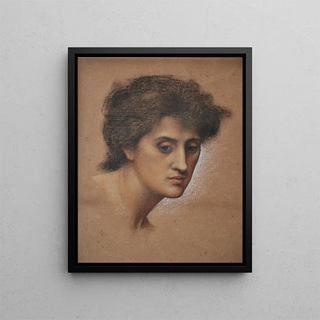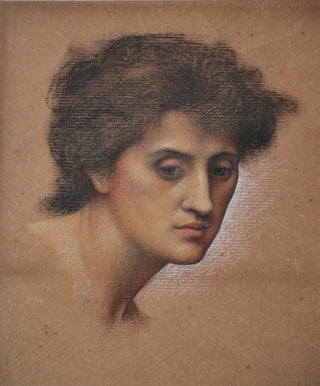Art print | Study of a female head for La Cadence de l'automne - Evelyn De Morgan


View from behind

Frame (optional)
The artwork "Study of a Female Head for La Cadence of Autumn" by Evelyn De Morgan is an iconic piece that beautifully illustrates the essence of the Pre-Raphaelite movement. This study, which foreshadows a larger painting, captivates viewers with its emotional depth and delicacy. Through the face of the depicted woman, the artist manages to evoke a gentle melancholy and an ethereal beauty, characteristic of her style. The finesse of the features and the intensity of the gaze invite introspective contemplation, making this work a gateway to a world where art and spirituality intersect.
Style and uniqueness of the work
Evelyn De Morgan stands out with her unique approach to painting, blending symbolist elements with romantic sensitivity. In this study, the chosen color palette, oscillating between warm tones and cooler shades, creates a mystical atmosphere. The meticulous details, such as the delicately rendered strands of hair and subtly worked shadows, testify to her exceptional craftsmanship. De Morgan does not hesitate to play with light to emphasize her characters' emotions, giving this female head an almost transcendent aura. This artwork does not merely depict a face; it tells a story, that of a soul seeking harmony and beauty in a often chaotic world.
The artist and her influence
Evelyn De Morgan, a major figure of the Pre-Raphaelite movement, managed to establish herself in an art world dominated by men. Her work addresses various themes, ranging from mythology to spirituality, including reflections on the role of women in society. Influenced by artists such as Dante Gabriel Rossetti and Edward Burne-Jones, she developed a distinctive style where the finesse of the features and the richness of symbols converge. De Morgan was also a pioneer in representing strong female figures, challenging the conventions of her time. Her legacy endures, inspiring many contemporary artists who seek to explore similar subjects with renewed sensitivity.
A wall decoration of

Matte finish

View from behind

Frame (optional)
The artwork "Study of a Female Head for La Cadence of Autumn" by Evelyn De Morgan is an iconic piece that beautifully illustrates the essence of the Pre-Raphaelite movement. This study, which foreshadows a larger painting, captivates viewers with its emotional depth and delicacy. Through the face of the depicted woman, the artist manages to evoke a gentle melancholy and an ethereal beauty, characteristic of her style. The finesse of the features and the intensity of the gaze invite introspective contemplation, making this work a gateway to a world where art and spirituality intersect.
Style and uniqueness of the work
Evelyn De Morgan stands out with her unique approach to painting, blending symbolist elements with romantic sensitivity. In this study, the chosen color palette, oscillating between warm tones and cooler shades, creates a mystical atmosphere. The meticulous details, such as the delicately rendered strands of hair and subtly worked shadows, testify to her exceptional craftsmanship. De Morgan does not hesitate to play with light to emphasize her characters' emotions, giving this female head an almost transcendent aura. This artwork does not merely depict a face; it tells a story, that of a soul seeking harmony and beauty in a often chaotic world.
The artist and her influence
Evelyn De Morgan, a major figure of the Pre-Raphaelite movement, managed to establish herself in an art world dominated by men. Her work addresses various themes, ranging from mythology to spirituality, including reflections on the role of women in society. Influenced by artists such as Dante Gabriel Rossetti and Edward Burne-Jones, she developed a distinctive style where the finesse of the features and the richness of symbols converge. De Morgan was also a pioneer in representing strong female figures, challenging the conventions of her time. Her legacy endures, inspiring many contemporary artists who seek to explore similar subjects with renewed sensitivity.
A wall decoration of






